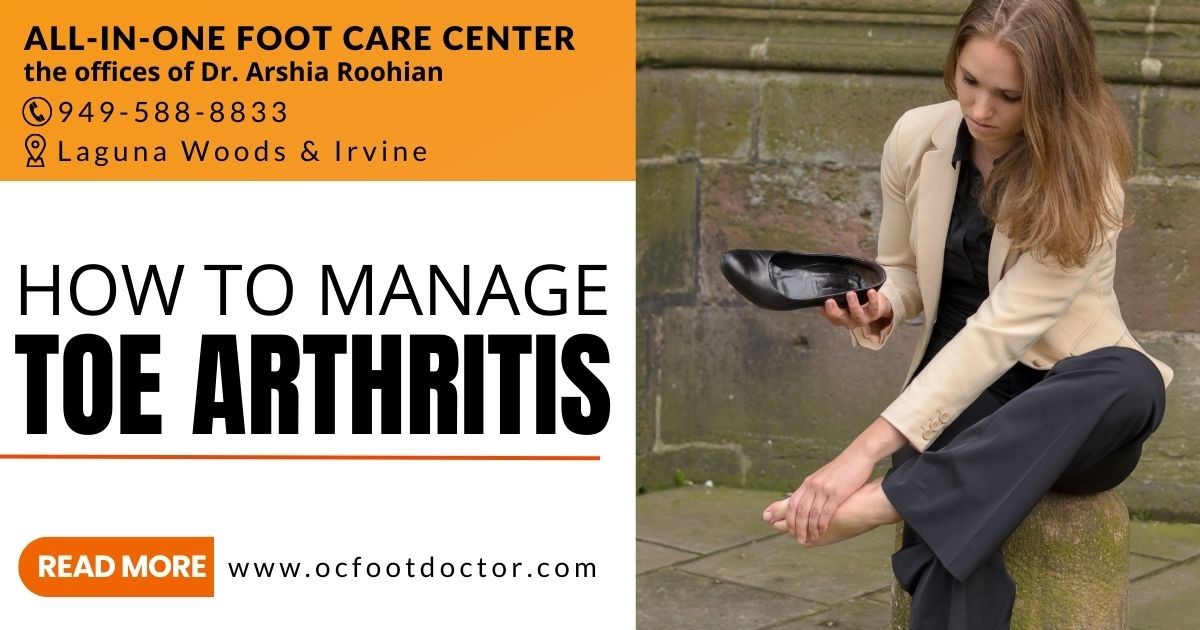How to Manage Toe Arthritis

As you walk, stand, and perform many other activities daily, your big toe absorbs forces almost twice your weight, which causes it to be at risk of injury over time.
Hallux rigidus, or a stiff toe, is caused by the wear and tear of the cartilage in the largest toe joint of your foot.
As a result of inflammation and stiffness associated with toe arthritis, walking, standing, and climbing stairs can be difficult. It is possible to slow the progression of arthritis, minimize symptoms, and decrease the risk of developing secondary symptoms like ankle pain as a result of a gait abnormality if arthritis is treated.
In Irvine or Laguna Woods, California, Dr. Arshia Roohian diagnoses and treats your feet at All in One Foot Care Center. In order to determine the best treatment for your symptoms, Dr. Arshia Roohian performs a thorough physical examination, a thorough health history, and diagnostic tests such as X-rays.
Dr. Roohian recommends conservative treatment over invasive treatments. Here are five tips for managing toe arthritis before considering surgery.
.jpg)
1. NSAIDs (nonsteroidal anti-inflammatory drugs)
An NSAID is a medication used to reduce inflammation, stiffness, and pain associated with arthritis. It includes over-the-counter medications such as aspirin, ibuprofen, and naproxen, and prescription medications such as celecoxib, diclofenac, and nabumetone.
NSAIDs block the production of hormone-like compounds called prostaglandins. Prostaglandins cause inflammation and pain.
In addition to being taken by mouth, NSAIDs can also be applied directly to the skin over painful joints. In cases where only one toe is affected by arthritis, a topical NSAID may be appropriate since it prevents your body from experiencing the side effects of NSAIDs. When used long-term, NSAIDs may cause kidney damage, ulcers, and high blood pressure.
.jpg)
2. Toe-stretching
It is possible to increase flexibility and range of motion by performing toe stretching exercises. It is also possible to slow the progression of toe arthritis by performing toe stretching exercises at an early stage of the disease.
As well as toe stretches, Dr. Arshia Roohian prescribes strengthening exercises for the muscles that support the alignment of the foot and lower limbs.
3. Make your shoes more comfortable by choosing them
A callus or bunion can make wearing some shoes uncomfortable if you have arthritis at the base of your big toe. Arthritis can cause cartilage degeneration and bone spurs, as well as pain and inflammation.
When choosing toe arthritis shoes, the right fit is crucial. Cushioning, arch support, and rigid soles can improve stability.
Since friction causes pain against bumps, calluses, or bunions, shoes with a narrow toe box contribute less to toe arthritis pain and inflammation. Due to the unnatural position of the foot in heels of two inches or higher, they can cause pressure on the big toe and develop toe arthritis.
.jpg)
Toe arthritis sufferers should have their feet measured before purchasing shoes. When shopping for shoes, look for the following characteristics:
- A wide-toe box accommodates bunions, deformed joints, and hammertoes
- There are two types of toe boxes: square and round
- Stiff soles that bend only at the toes (where you bend your foot)
- A shoe's heel counter (the part of the shoe that cups the heel) must be stable in order to provide stability and prevent friction.
- Insoles that can be customized with orthotics
- You should have extra depth on your toes in order to avoid friction
- Heels should not exceed two inches in height
4. Orthotics should be worn by you
Orthotics are shoe inserts or heels that help relieve foot pain. A custom orthotic is made from a mold or digital image of your foot.
The Custom orthotics can also be made to treat specific conditions, deformities, or types of arthritis, in addition to being made to fit your exact foot size and shape.
5. Consider Supartz injections
A viscosupplementation procedure involves administering Supartz, a sodium hyaluronate solution. Supartz provides shock-absorbing properties to protect and lubricate the treated joint.
A series of weekly injections of Supartz is usually administered over a period of three to five weeks. Successful treatments can provide pain relief for up to 12 months.
You can contact our office at 949-588-8833 , or visit our website at https://www.ocfootdoctor.com/ Our offices are located in Laguna Hills, Irvine, Mission Viejo, Aliso Viejo, Lake Forest, Foothill Ranch, and Costa Mesa.


